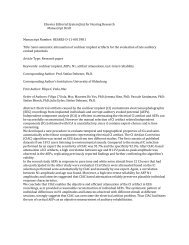An analytic Green's function for a lined circular duct containing ...
An analytic Green's function for a lined circular duct containing ...
An analytic Green's function for a lined circular duct containing ...
Create successful ePaper yourself
Turn your PDF publications into a flip-book with our unique Google optimized e-Paper software.
ARTICLE IN PRESS<br />
Finally in order to show the behaviour of the <strong>analytic</strong>al and numerical Green’s <strong>function</strong> continuity at the<br />
source plane away from the source position, Fig. 12 <strong>for</strong> the zero flow case, shows the variation in the radial<br />
direction at the source plane, at the same azimuthal angle as the source, of the modulus of the azimuthal mode<br />
number amplitudes and also the total field, in dB. Shown <strong>for</strong> comparison is the free-field Green’s <strong>function</strong><br />
1=ð4pRÞ, where R is the distance from the source at r0 ¼ 1, multiplied by a plane wave correction to account<br />
<strong>for</strong> the reflection or image source in the <strong>lined</strong> <strong>duct</strong> wall equal to 2Z1=ðZ1 þ 1Þ. It can be seen that the<br />
agreement between the <strong>analytic</strong>al and corrected free-field Green’s <strong>function</strong> <strong>for</strong> this zero flow case is very good<br />
and that continuity (i.e. the total field made up of right running modes ðþÞ equals the total field made up of<br />
left running modes ð Þ) at the source plane is achieved away from the source position—these are<br />
indistinguishable <strong>for</strong> this zero flow case. Here we have decreased the cut-off ratio to 0.07 <strong>for</strong> the <strong>analytic</strong><br />
Green’s <strong>function</strong> evaluation but had to limit the numerical Green’s <strong>function</strong> evaluation to 40 cut-off radial<br />
modes to avoid serious corruption of the solution due to ill-conditioned matrices <strong>for</strong> the higher azimuthal<br />
modes.<br />
The corresponding radial dependence <strong>for</strong> the mean flow case is shown in Fig. 13. Here we have also used a<br />
cut-off ratio of 0.07 <strong>for</strong> the <strong>analytic</strong> Green’s <strong>function</strong> evaluation and again 40 cut-off radial modes <strong>for</strong> the<br />
numerical version. This figure shows that we achieved comparable accuracy to the no-flow case in respect of<br />
continuity at the source plane and the agreement with the free-field Green’s <strong>function</strong> verifies that we have<br />
|G− m |, dB<br />
Phase(G− m ), radians<br />
0<br />
−10<br />
−20<br />
−30<br />
−40<br />
0 50 100<br />
Radial Mode Number<br />
150 200<br />
3<br />
2<br />
1<br />
0<br />
−1<br />
−2<br />
S.W. Rienstra, B.J. Tester / Journal of Sound and Vibration 317 (2008) 994–1016 1009<br />
−3<br />
0 50 100<br />
Radial Mode Number<br />
150 200<br />
|G + m |, dB<br />
Phase(G + m ), radians<br />
0<br />
−10<br />
−20<br />
−30<br />
−40<br />
28<br />
24<br />
20<br />
16<br />
12<br />
8<br />
4<br />
0<br />
0 50 100<br />
Radial Mode Number<br />
150 200<br />
3<br />
2<br />
1<br />
0<br />
−1<br />
−2<br />
−3<br />
0 50 100<br />
Radial Mode Number<br />
150 200<br />
Fig. 10. <strong>An</strong>alytic Green’s <strong>function</strong> azimuthal mode amplitude convergence (o ¼ 28, M ¼ 0:45, Z1 ¼ 2:5, r0 ¼ 1, cut-off ratio ¼ 0:07).<br />
Behaviour of left (a) and right (b) running mode amplitude, left (c) and right (d) running mode phase.
















